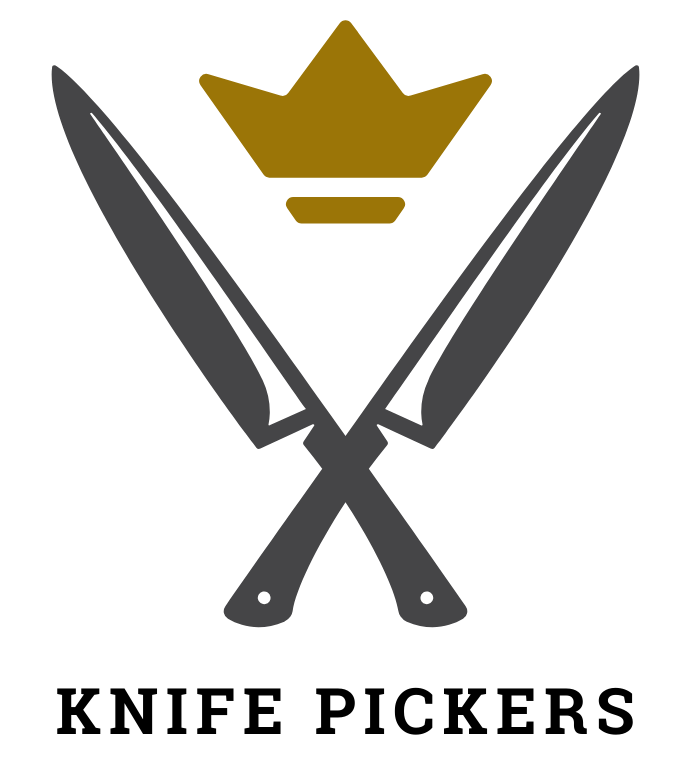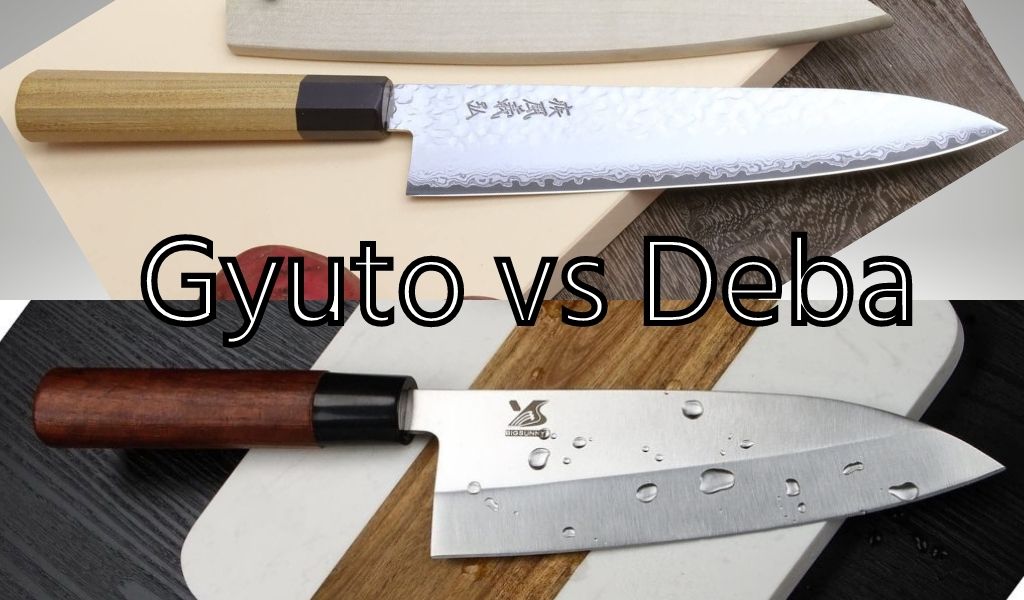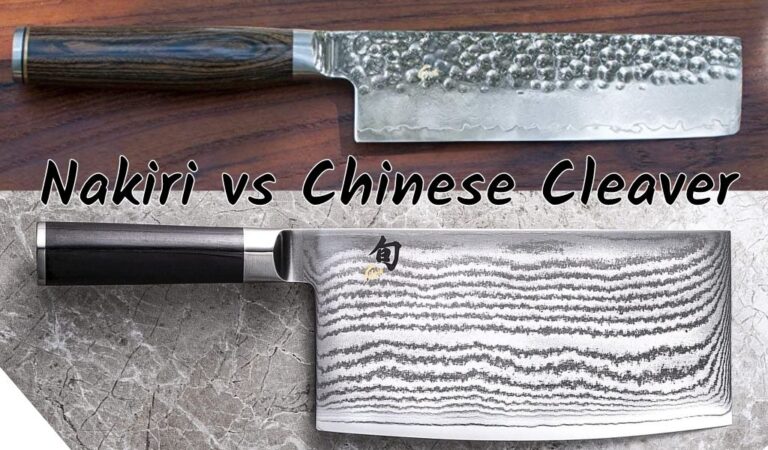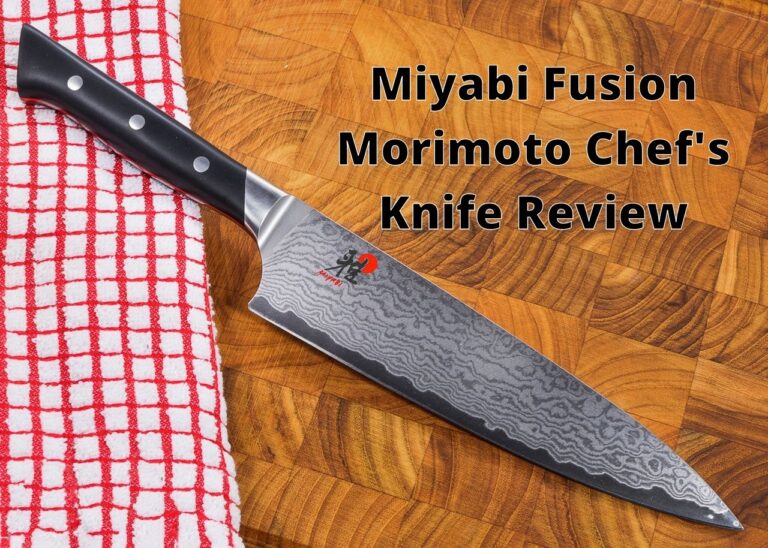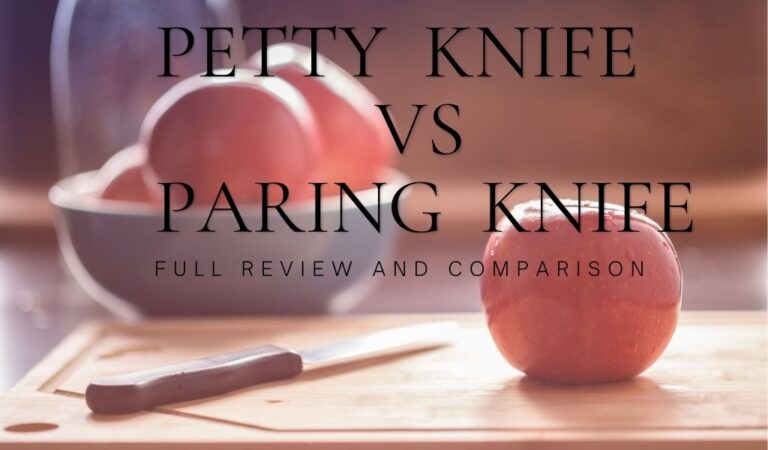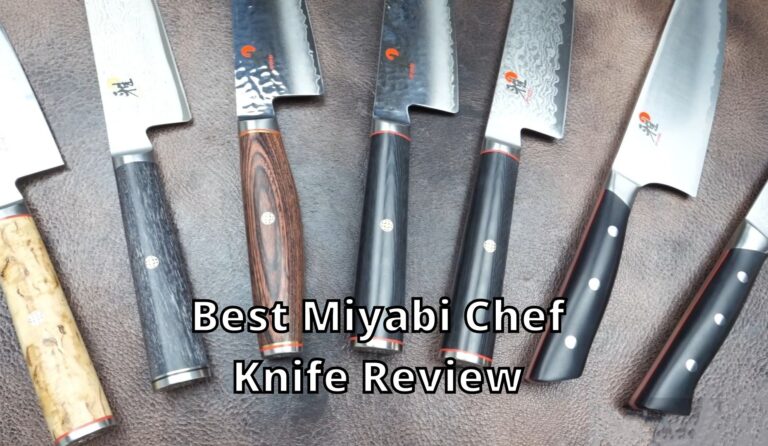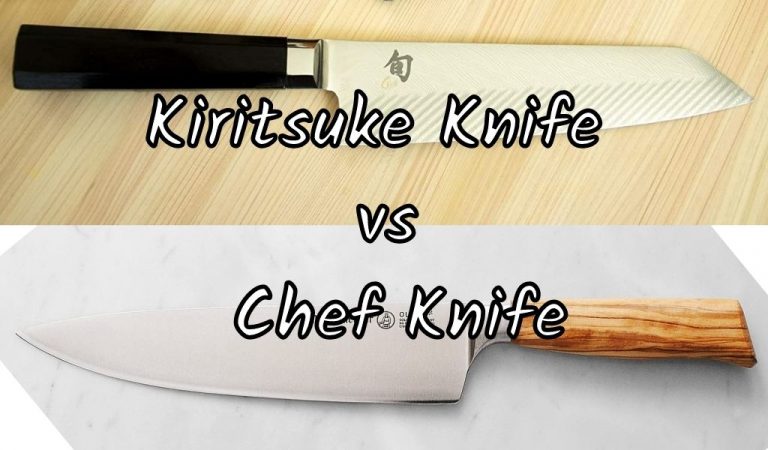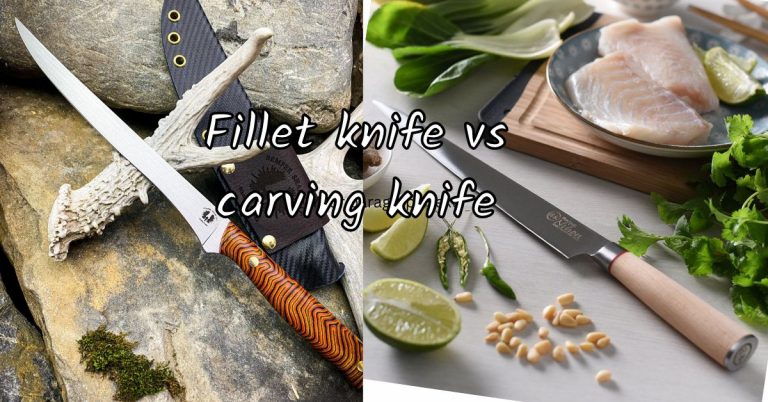Deba and gyuto are two traditional Japanese knives that have become very popular in the Western kitchen. The deba is a heavy-duty, thick blade used for breaking down fish. while the gyuto is more versatile and lighter and has many uses including slicing vegetables. These two types of knives have both similarities and differences in terms of different features, look, and purpose.
Let’s go through this whole deba and gyuto to know more about these two types of knives. Also, we will know about different types of deba knives and gyuto knife.
Comparison Table: Deba vs Gyuto Knife
If you are in hurry, then before going through this whole yo deba vs gyuto you can go through this quick comparison table.
| Gyuto Knife | Deba Knife | |
| Origin | Japan | Japan |
| Category | Modern Allrounder | Traditional |
| Blade Profile | Belly Curves, Low pointy tip | Belly curves, High Pointry Tip |
| Blade spine | Straight spine | Downward Curving spine |
| Function | Copper, Mincer and Slicer | Cut meat from bones and head of fish |
| Kinds of Food to Cut | Fish, meat, vegetable | Fish |
| Handle | Octagonal, round | Octagonal, Round |
Top 3 Gyuto Knife
| Best Overall | Best Affordable | |
What is Gyuto Knife?
Gyuto is a Japanese version of the classic western-style chef’s knife. It is similar to the western chef’s knife, but it has a slightly wider blade and shorter handle. The Gyuto is a versatile, multi-purpose knife that is suitable for cutting the vast majority of meats, fish, vegetables, fruits, and herbs.
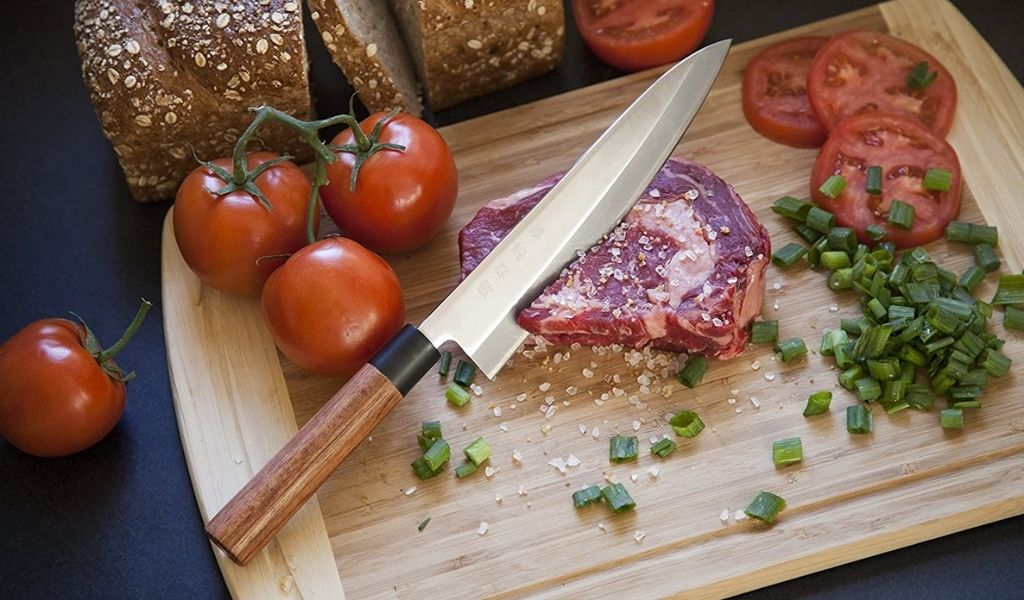
A gyuto is a type of knife that has a blade that is long and straight. It is also tall at the heel, curved in the middle, and pointed at the tip.And the blade is flat on one side with a slight curve from the middle to the tip. This curve makes it good as chopping cleaver knife. The belly of the blade curves slightly upwards towards the tip.
This Japanese chef’s knife features a thinner, lighter double-bevel blade. This type of knife holds an edge better than Western knives and is versatile for most user needs.
Top 3 Deba Knife
| Best Overall | Best Under $100 | Best Affordable |
What is Deba Knife?
The deba is a Japanese-style knife that has a thick spine and a sharp blade edge that is pointed at the tip. The deba is traditionally used for cleaning, filleting, and beheading fish. But its sturdiness and weight also help to break down poultry and other meat with small bones as well.

The Deba knife is not designed to cut through large bones or thick meat. Applying pressure that is perpendicular to the blade length can chip or crack the blade.
Deba knife is also called deba-bocho. we can see that it has a characteristic shape like a thick blade and the back edge is not sharp. Usually, this thick blade features an overall length of between 26 and 30 cm.
As traditional Japanese knives, most Debas are single bevel knives.So, only one side of the blade is ground to form a razor-sharp edge. Combined with the weight, the wide asymmetrical blade allows you to effortlessly glide through delicate fish and create clean deep cuts.
Origin of Gyuto and Deba Knife
The origin of the word “gyuto” is from Kyoto, Japan. The word gyuto means “cow sword” but it’s not a sword made from cow leather. It was nicknamed “cow sword” because it was stored in the same place as swords used for cutting cows and fish.
The history of Japanese gyuto knife is quite interesting. The first versions of gyuto knives appeared in the mid-1500s and were created in Japan. The blade of these knives was much thicker than the modern ones. They were used for chopping wood and bone. The handles were made of wood, without the use of metal fittings.We will know more about the construction of gyuto through this gyuto vs deba review.
Deba knife, a kind of Japanese traditional kitchen knife, was invented by Sakai Takayuki in the early 18th century. Deba has a unique structure and high quality. This knife was so useful then because they were used for filleting boneless fish.
This Japanese-style Deba knife was derived from deba-Kiri which means beheading knife. As the knife evolved, it gained a more pointed tip and a wider blade. It has a handle similar to usuba, but the blade is much heavier and thicker.
You will find Deba knife commonly in Japanese cuisine.In the modern-day, it has become a part of some popular recipes like sashimi, sushi, etc.
Gyuto vs Deba Knife: In-depth Comparison
Design
The main difference between these two Japanese knives can be seen in their design. As we mentioned earlier in this yo Deba knife vs gyuto knife review, a Gyuto is an all-purpose knife while a Deba is very task-specific. That’s why, a Gyuto has a larger blade that can handle a wider variety of ingredients and food.

On the other hand, Deba has a thinner blade that’s about 5-8 inches long. This allows it to glide through the skin and flesh of a fish easily. It also has a flatter profile than most Western knives. That’s why you have to use a push and pull motion with these blades instead of a rocking-chop style.
The front side of the blade has a flat edge for filleting.And the backside has a sharp V-shaped edge called uchiko which can be used to remove bones, scales, and other tiny pieces of flesh from the fish.

Construction
These two blades are both Japanese, so they have a lot of similarities. They are made with top craftsmanship and attention to detail. But like with any other knives, the construction varies depending on the brand and model. Most Japanese blades will be forged out of a single piece of high-carbon steel.
Gyuto and Deba knives also come with a Damascus construction. This involves hammering multiple thin layers of steel over a very tough core.That creates a beautifully unique pattern on the blade. The Damascus technique also results in a much stronger and more durable blade.
Edge
Both of these knives come with incredibly sharp edges. A Gyuto is usually double-beveled as it is a Japanese iteration of the Western chef knife. Typically, the edge of gyuto will be sharpened down to around 10-15 degrees on either side. This is much sharper than a standard Western blade.
Deba knives have a different story than gyuto and Western chef knives. Deba knives are used for breaking down fish and meat. These knives come mainly as a single bevel blade but you can also find dual bevel deba.No matter the knife you choose, you’ll be getting an incredibly sharp edge that is built to last as described before in this deba and gyuto.
Shape
Deba knife is a Japanese kitchen knife with a short and wide blade. The blade is thickest at the heel, where it meets the handle (the tang), and tapers toward the cutting edge. It has a pointed tip.And its most distinctive feature is its backside, which slopes at an obtuse angle, allowing it to cut off fish.
On the other hand, Gyutos are long Japanese chef’s knives that are commonly tall and flat at the heel with a slight curve from the midsection to the pointed tip of the blade. The relatively flat heel of the blade makes it well-suited for a variety of chopping styles such as thrust-cutting. Moreover, As mentioned before in this miyoroshi deba vs gyuto its slight belly towards the tip of the blade allows for easy cuts.
Size
A Deba knife is designed to work with whole fish. A Deba is used to remove the head of the fish as well as fillet it. Due to this function, it is especially important that a Deba be heavy in order to cut through bones while feeling well balanced in the user’s hand.
The Deba knife is available in several styles, but the most common is the Hon-Deba (literally, ‘true deba ‘). Hon-Deba knives have sharp, tough blades that are typically 150mm to 330mm in length and 5mm to 9mm thick. For average knife user, a 180mm deba blade length is recommended.
Like the western-style chef’s knife, the Gyuto typically features a long blade and is available in several blade lengths between 180mm to 210mm. For the average user, a gyuto blade length of 240mm is best recommended. Because a longer blade gives additional versatility for cutting larger products.And it also remains light enough in the hand to feel comfortable.
Handle
Knife handles can be divided into two categories: the traditional Japanese Wa-Handle, and a Western handle. Most Deba knives feature a wooden Wa-Handle.
The Gyuto is available in either a western-style or Japanese-style handle. A Gyuto with a Japanese-style handle is called a Wa-Gyuto. Most wa-handles are D-shaped, oval, or octagonal shaped and come in various lengths. It’s up to the chef to decide which style of the handle feels right in their hand.
What deba knife is best used for?
A Deba knife is used for cutting through whole fish, including filleting the fish and cutting through its bones. The significant weight of the blade allows you to make strong cuts and cleanly slice through even the toughest parts of the fish. It is also commonly used to cut poultry meat as well as other meats with small bones.
Like most other Japanese knives, Deba is a specialized knife that works best while doing what it was created to do. It is especially useful when working with whole fish, as every part of the blade serves a specific purpose. The sturdy heel allows you to easily remove the fish head and tail cut through small bones.

The smaller pointed tip allows you to feel the bones and helps you to filet the flesh from the bones. The center of the edge allows you to glide along the spine and carve as closely to the bone as possible.It can also be used for slicing, filleting, and removing fish skin and scales as described again and again in this whole yo deba vs gyuto comparison.
If you’re used to using a Western-style fillet knife or even just your chef’s knife for handling fish, the Deba may feel a little foreign in your hands at first. But with just a little practice to master the cutting technique, the Deba will minimize damage to your fresh fish.And it will reduce waste and produce beautifully deep and precise cuts, making you feel perfect.
What Gyuto knife is best used for?
The gyuto knife is best for chopping, slicing, mincing, and dicing boneless meat, fish, vegetables, fruit, and herbs. It is a true multi-tasker in the kitchen of a homecook or prfessional chef.
The Gyuto is good for a variety of food preparation tasks. For example, the relatively flat heel of the blade can be used to tap-chop or thrust-cut soft vegetables. The slight curve from the middle of the blade leading to its pointed edge can be used to rock-chop stiffer vegetables or herbs.
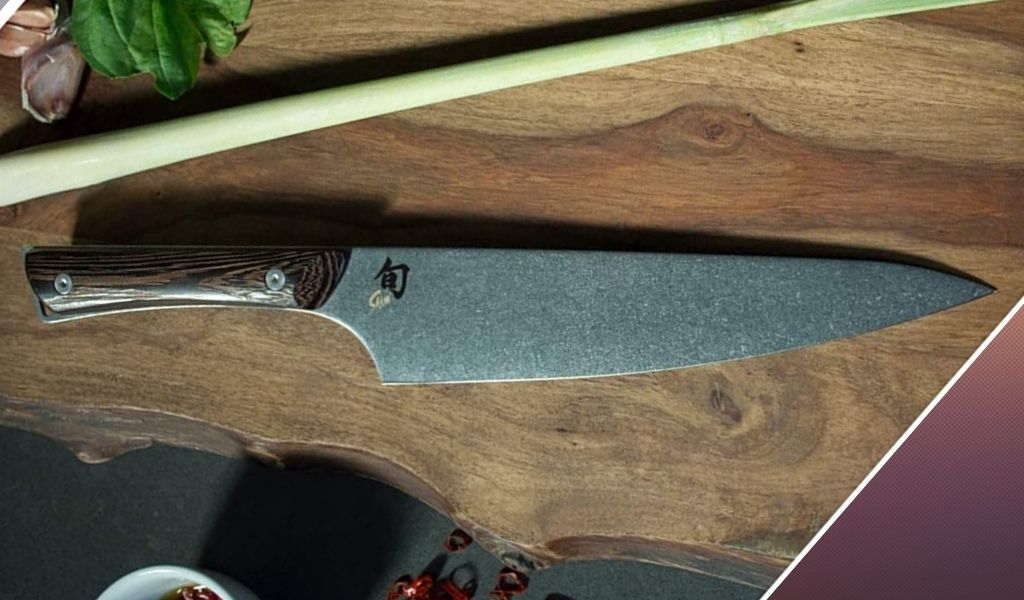
As mentioned earlier in this Miyoroshi deba vs gyuto, The blade of the Gyuto is thinner, lighter, and sharper than a western chef’s knife. It makes it easier to handle and the ideal tool for preparing any kind of dish. Generally, the types of steel used to make a Gyuto are harder than that of a western chef’s knife.
Different Types of Deba Knives.
Ko-Deba/Aji-Deba
The Ko-Deba is a smaller deba used for cleaning and filleting small saltwater and freshwater fish. The word ‘Ko’ in Japanese translates to “small” or “short” in English.
Ai-Deba
The ai-deba is a thinner and lighter version of the hon-deba, with a narrower blade that ranges from 135mm to 270mm. The word “ai” in Japanese translates to “both” in English. And it refers to the ai-Deba’s exceptional ability to both fillet and slice medium-sized fish.
Yo-Deba
The Yo-Deba is a Western-style variant of the Hon-Deba. It features a double bevel edge and the blade length of the Yo-Deba ranges from 165mm to 300mm.
Mioroshi-Deba
The Mioroshi-Deba is a knife used for filleting fish and has a blade that is 165mm to 330mm long. The name comes from the fact that the blade was designed such that it could be used in place of both the Deba and Yanagiba. It saves fishermen from having to carry both knives in their boats.
Kanisaki Deba
The Kanisaki-Deba is a specialized Deba for cutting and filleting shellfish. The blade length ranges from 180mm to 210mm. The unique thing about this knife is that its cutting edge is ground on the left side for right-handed knives. This is done so that the knife won’t cut into the crab meat while cutting.
Different Types of Gyuto Knives

Wa Gyuto
The Wa-Gyuto is a Japanese knife with a traditional Japanese handle. The wa-handle is made of wood, while the balance point is closer to the tip of the blade, which allows the knife to do most of the cutting work for you. The forward balance of the wa-handle makes it easier to wield, especially when directing the sharp tip of the blade
Kiritsuke Gyuto
The Kiritsuke Gyuto is a variant of the Gyuto knife, with an angled ‘reverse tanto’ tip. It was made popular in Japan by Kurosu Seisakusho, who specializes in kitchen knives and their manufacture. The K-tip Gyuto is different from the typical Gyuto in that its edge is very flat instead of slightly edge.
FAQ
1. What is the best deba knife?
With beautiful design and quality material, the Kai wasabi black deba knife is one of the best deba knives. This deba knife is a perfect combination of quality and affordability. Other companies like Yoshihiro, tojiro produce quality deba knives.
2. What is the best gyuto knife?
If you want a high-end and beautiful-looking gyuto knife then you can go with the miybai birchwood gyuto knife. There are other quality gyuto knives crafted by Shun, miyabi, Kamikoto, Kanetsuke, and Seto. One of them is the Shun Classic and Shun premier gyuto.
Which one should you choose? Gyuto or Deba?
As we mentioned earlier through this whole Gyuto vs deba review, a Gyuto is designed for multiple purposes task. A Deba, on the other hand, is only designed to handle fish.
So, if you’re looking for an all-around and multipurpose knife for your kitchen, Gyuto is what you’re looking for. If you need something that is task-specific and can handle filleting and cutting fish with unmatched ease, then a Deba would fit in very well in your kitchen.
Conclusion
If you have gone through this whole deba and gyuto then you must have got a clear idea about these two types of knives. The gyuto and deba knives are both wonderful knife options with very different styles. Both of the knives are very good got at their work. They have their own strengths and weaknesses. It all comes down to personal preference, so you’ll just need to decide which type of blade you like the best and which will help you perform the tasks that you need it to.
Other Comparisons:
